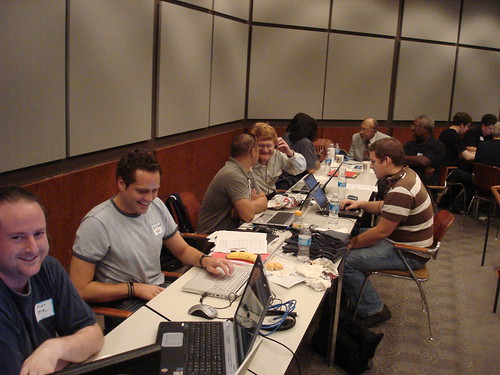Do most nonprofits really need groups of volunteers from corporations or other organizations showing up for one-day volunteering activities?
I’ve been thinking about this for a few months lately, and now the British-based company nfpSynergy has scooped me with its own thoughts on whether or not corporate volunteering really all its cracked up to be. An excerpt from its blog:
There is nothing more difficult to deal with than an employer who rings up a charity offering 30/300/3000 employees who want to do a bit of volunteering as part of their team-building on Thursday afternoon in three weeks time. Charities quietly (for fear of upsetting their corporate partners) dislike employee volunteering while companies are much more enthusiast.
It’s so true!
I started thinking about blogging about this myself when I saw that a certain corporation had won a certain state’s group volunteering award for its participation in a range of one-time events. IMO, this corporation was being honored for “volunteering” in events that had been created more to accommodate the corporation and others looking for a one-time, feel-good experience (and photo ops) than to actually make a difference in the community.
As any person who has worked with nonprofits knows, one-time volunteering events – walks, runs, dances, auctions, benefit performances, beach clean-up days, house painting, etc. – are very expensive and time-consuming. They are worthwhile for most organizations only if they result in one or more of the following:
- measurable results regarding community awareness of a particular issue or organization
- candidates for longer-term volunteering in more substantive activities regarding service delivery
- funds raised to cover all costs, including staff time to organize and supervise the event, insurance, etc.
A school once asked me if it had to accept a corporation’s request for a group of their employees to hold a pizza party for two of their classes of fourth graders just before the students went home on an upcoming Friday. The corporation considered this as somehow a great thing for the kids, and as a volunteering experience for their employees. The teachers balked at losing even an hour of teaching time, and saw nothing beneficial about such an event for the kids whatsoever. They were reluctant to tell the corporation no, however, for fear of losing the chance of a grant down the road. The school representatives were at first stunned, and then relieved, when I told them they had every right to refuse any such offer, that they could say, “Thanks so much. Because every hour of teaching time is vitally important, we can’t do anything that takes away such time. But here’s information about our lunch-time mentoring program; we would love any of your employees attend our next orientation about this program. Or we could do a presentation at your corporation about the program and how your employees could get involved. We have some other volunteering activities we would welcome your help with as well.”
(In case you are wondering, the corporation declined. Lunch time one-on-one mentoring wasn’t the kind of experience their employees were looking for, and they didn’t have time for employees to sit through a presentation by the school. Sigh.)
The nfpSynergy blog continues, with an experience very similar to my own:
For nearly five years now nfpSynergy has had a company policy of giving each employee 5 days of paid volunteering time. Doesn’t that make us wonderful? Well no not really because it didn’t work: very few staff used their volunteering days. And this is despite the fact that almost everybody who works for us is very committed to the charities and non-profits.
So why didn’t people use their volunteering days? The answer is simple. Five days is ‘diddly squat’ in the world of volunteering. It was like telling people they could go and buy a free lunch on the company but only giving them 10p with which to do.
My experience exactly: once upon a time, I ran the philanthropy activities for what was then a Fortune 500 company with hundreds of employees at headquarters and at another location in the USA, and thousands abroad. We also gave USA employees five days of paid time off to volunteer. In the two years I oversaw the program, less than a dozen individual employees took the days. Only two groups of employees did, in events organized by me: people from our facilities department painted a room at a nearby family homeless shelter, and three employees from our IT department networked the new computers of a nearby nonprofit over two days. It took me twice as many hours to organize these two group volunteering events as it took the volunteers to actually do them!
Right now, I’m trying to find group volunteering activities for Girl Scouts in my area. And the reality is that, not only are most organizations not prepared, in terms of insurance, supervision and program, to host groups of girls under 16 (most under 13, in fact) as volunteers, most organizations do not want a group of young girls as volunteers; the staff have critical activities that must be taken care of, that cannot be delayed in order to give a group of young girls a feel-good experience.
Attention corporations and governments: if you want to see more group volunteering activities by corporate employees, youth groups, professional associations, etc., prepare to pay for it. Money is needed to fund the staff, material, training and other resources to not only make the activity happen, but to make the activity a meaningful part of the organization’s mission or outreach efforts.
Also see:
Creating One-Time, Short-Term Group Volunteering Activities
One(-ish) Day “Tech” Activities for Volunteers
Finding Community Service and Volunteering for Groups
Pro Bono / In-Kind / Donated Services for Mission-Based Organizations: When, Why & How?


 A blog today
A blog today